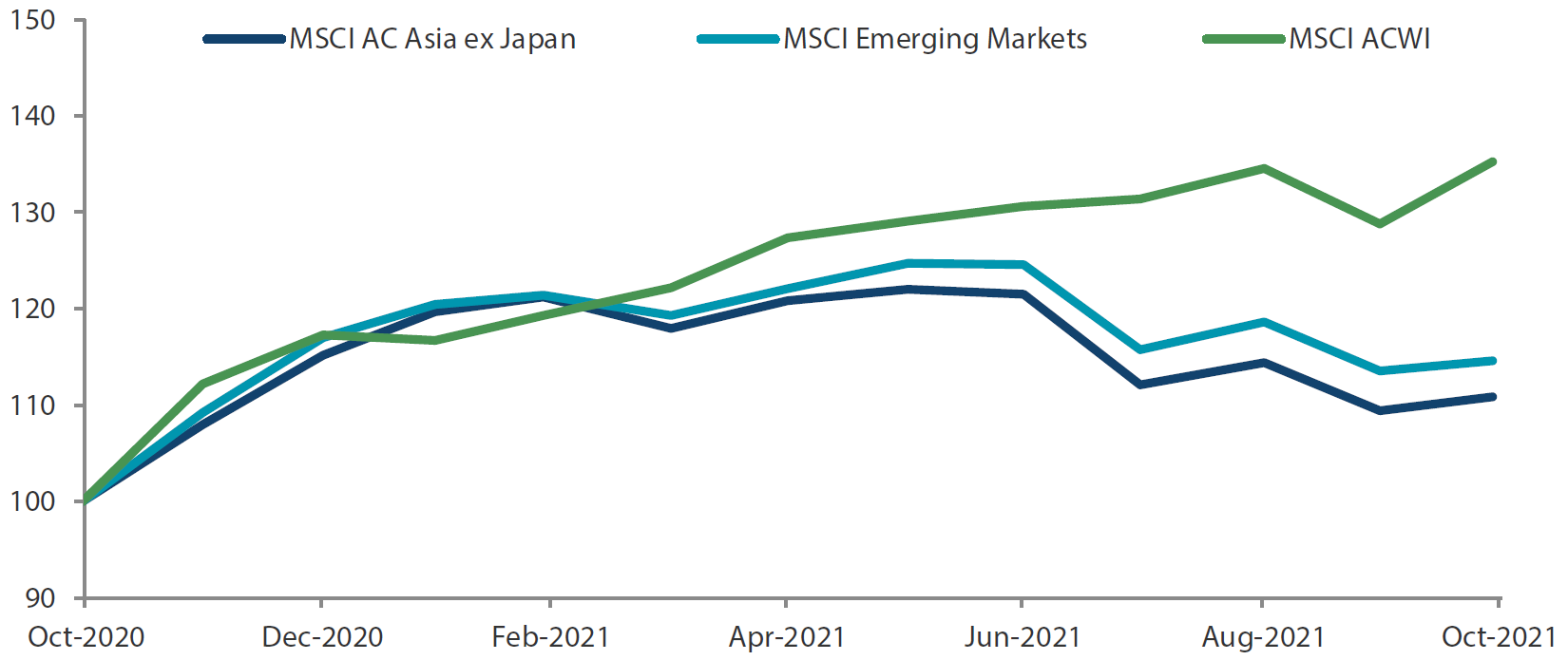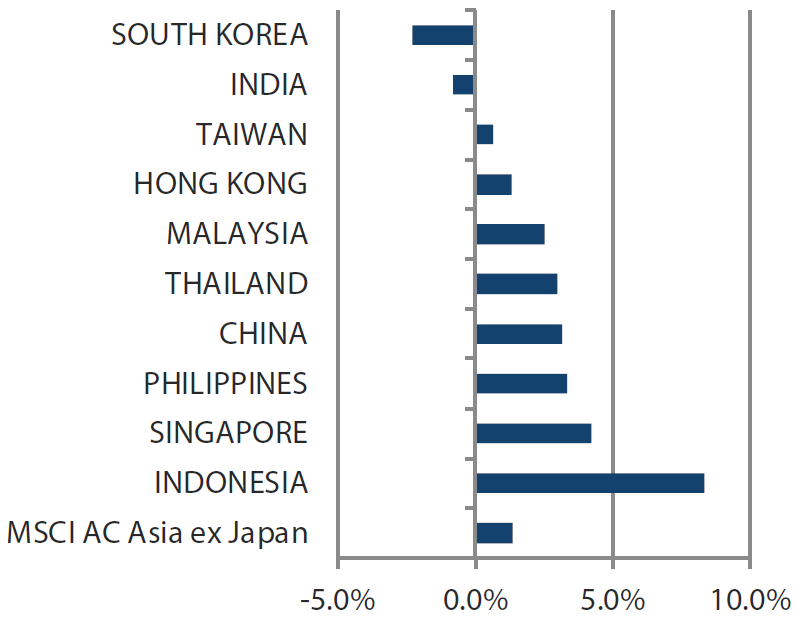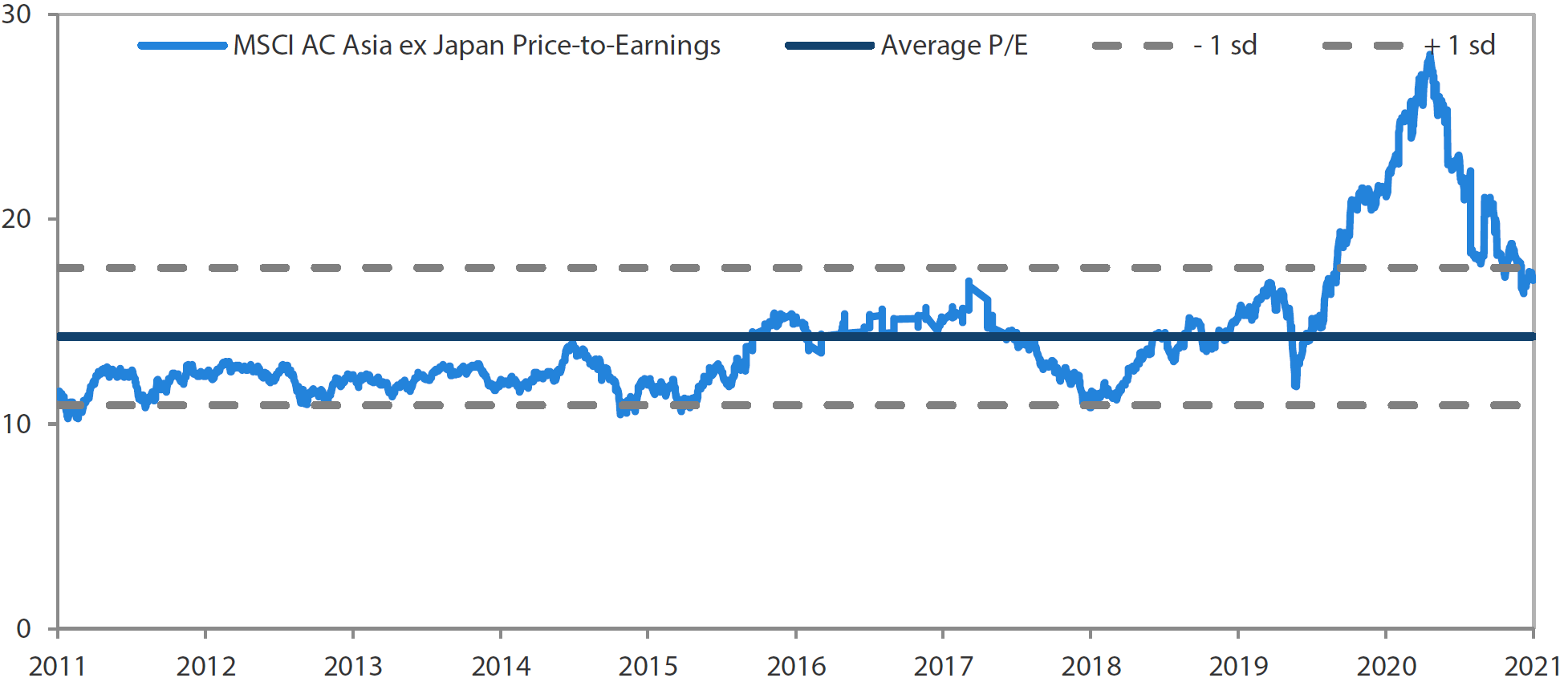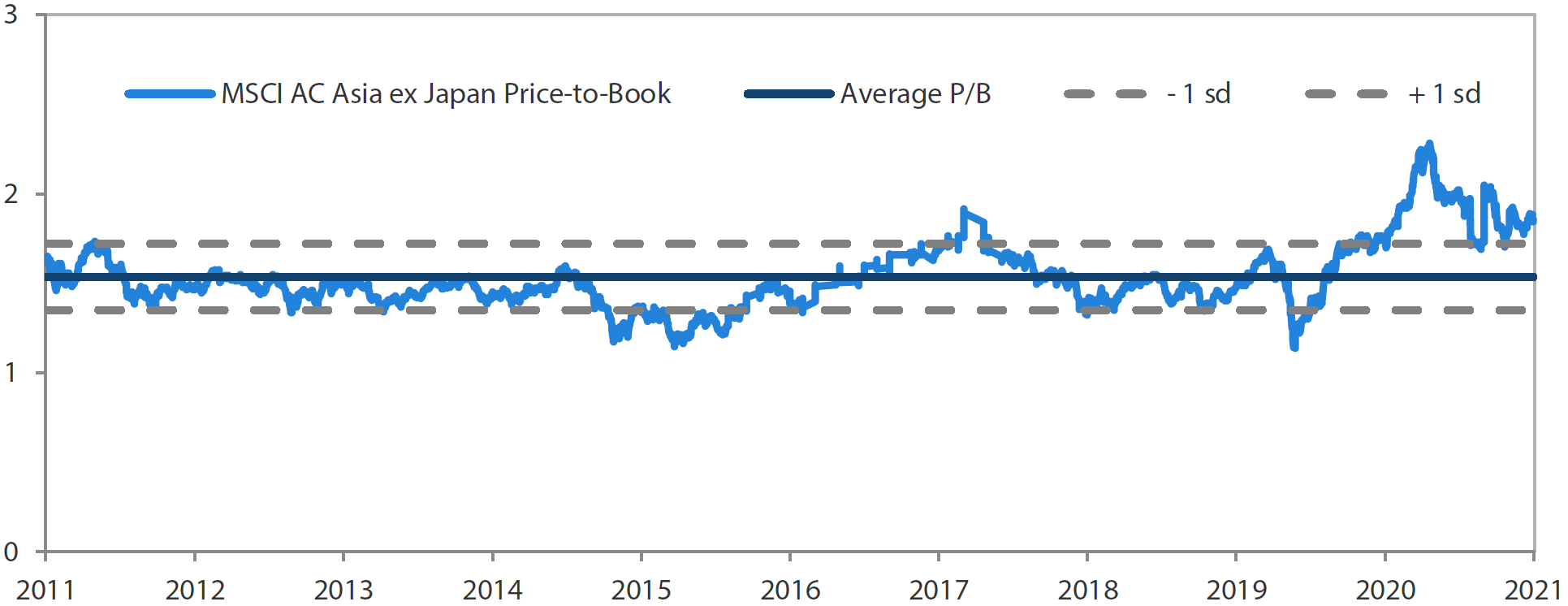Summary
- Asian stocks rose in October. Investors remained focused on rising inflationary pressures and the US Federal Reserve’s (Fed) tapering plans. For the month, the MSCI AC Asia ex Japan Index gained 1.4% in US dollar (USD) terms.
- The ASEAN region outperformed, buoyed by the gradual reopening of borders. North Asia generally saw positive returns: China rose on expectations of policy loosening to combat an economic slowdown. South Korea bucked the trend and was the worst-performing market in the region, weighed down by the global chip shortage and supply chain disruptions.
- India saw a return of -0.8% in USD terms in October. The Reserve Bank of India’s plan to drain liquidity from the banking system for longer periods weighed on investor sentiment.
- Conversation centres around how China slowing down would affect the rest of the world, and what this means for the commodity and energy complexes. On the other hand, high levels of public debt and diminishing fiscal headroom make the case for a “lower for longer” investment environment. Vacillating between these two camps makes for choppy markets. We believe that a disciplined investment approach focused on company fundamentals is therefore essential.
Market review
Regional equities gain in October
Asian stocks rose in October in tandem with the US stock market, which reached new highs on the back of robust corporate earnings. Investors remained focused on rising inflationary pressures and the US Federal Reserve (Fed)’s tapering plans. Minutes of the Fed’s meeting revealed the central bank will most likely begin tapering its asset purchases in November.
For the month, the MSCI AC Asia ex Japan Index rose by 1.4% in US dollar (USD) terms. Indonesia and Singapore were the best performers, while South Korea and India were the only markets to post negative USD returns.
Chart 1: 1-year market performance of MSCI AC Asia ex Japan versus Emerging Markets versus All Country World Index
 Source: Bloomberg, 31 October 2021. Returns are in USD. Past performance is not necessarily indicative of future performance.
Source: Bloomberg, 31 October 2021. Returns are in USD. Past performance is not necessarily indicative of future performance.
Chart 2: MSCI AC Asia ex Japan versus Emerging Markets versus All Country World Index price-to-earnings
 Source: Bloomberg, 31 October 2021. Returns are in USD. Past performance is not necessarily indicative of future performance.
Source: Bloomberg, 31 October 2021. Returns are in USD. Past performance is not necessarily indicative of future performance.
ASEAN outperforms
The ASEAN region outperformed in October. All markets saw positive returns, with Indonesia (+8.3% in USD terms) and Singapore (+4.2%) gaining the most. The Indonesian finance ministry raised its 3Q21 GDP growth forecast to 4.5%, while the central bank extended policies to boost loan growth and consumption, seeking to bolster a recovery driven by commodity exports and border reopening. Reopening momentum also gathered pace in the rest of the region, with Singapore, Malaysia and Thailand expanding their vaccinated travel arrangements.
North Asian markets see positive returns, with the exception of South Korea
China (+3.2%) and Hong Kong (+1.3%) also ended the month higher, on expectations of Chinese policy loosening to combat an economic slowdown. China’s GDP increased by 4.9% year-on-year (YoY) in 3Q21, its slowest pace of expansion in a year. The official manufacturing Purchasing Manager’s Index (PMI) moderated to 49.2 in October from 49.6 in September, largely owing to the recent power shortages. A fresh COVID-19 outbreak and a sell-off in its property sector, fuelled by more Chinese real estate companies failing to make payments on their offshore bonds, weighed on sentiment toward the month-end.
Elsewhere in North Asia, Taiwan edged higher by 0.6% in October. GDP grew by 3.8% YoY in 3Q21, with exports and private investment remaining healthy despite COVID-19 restrictions weighing on consumption. Towards the end of the month, shares of Apple suppliers Foxconn and Taiwan Semiconductor Manufacturing Company (TSMC) fell after Apple reported revenue that missed expectations. South Korea declined by 2.3% and was the worst-performing market in the region. The country’s factory activity grew at its slowest pace in 13 months in October, as the global chip shortage and supply chain disruptions weighed on the sector.
India underperforms
India saw a return of -0.8% in USD terms in October. The Reserve Bank of India’s plan to drain liquidity from the banking system for longer periods weighed on investor sentiment. There were also concerns over a possible power crisis after coal supply at Indian utilities hit critically low levels. That said, India has reopened to tourists from mid-October after having administered over 1 billion doses of COVID-19 vaccines.
Chart 3: MSCI AC Asia ex Japan Index¹
| For the month ending 31 October 2021 | For the year ending 31 October 2021 | |

|

|
Source: Bloomberg, 31 October 2021
¹Note: Equity returns refer to MSCI indices quoted in USD. Returns are based on historical prices. Past performance is not necessarily indicative of future performance.
Market outlook
Leaning on disciplined stock picking approach to navigate uncertain macro conditions
Google searches for “stagflation” have risen to levels last seen during the Global Financial Crisis. The argument is that central banks tightening, or looking to tighten, monetary policy to counter inflation would drain liquidity from the economy just as the economy starts to slow. The water cooler conversation centres around how China slowing down would drag the rest of the world down with it, and what this means for the commodity and energy complexes, which have had a good year. On the other hand, the high levels of public debt and diminishing fiscal headroom are grounds to argue that rates will not rise to what was considered “normal” levels a decade or so ago, perpetuating the “lower for longer” investment environment. Vacillating between these two camps makes for choppy markets. We believe that a disciplined investment approach, one that is focused on company fundamentals, is therefore essential.
Focus on environmental technology, industrial automation and innovative healthcare in China
US Commerce Secretary Gina Raimondo stated that Washington wanted to slow down China’s rate of innovation by working “with…European allies to deny China the most advanced technology so that they can’t catch up in critical areas like semiconductors”. Also, China imports more than two-thirds of its energy needs via oil and natural gas imports. To reduce external dependency, the Chinese government has decided to develop the requisite intellectual property and energy resources domestically. However, this requires investment and time, translating to slower, albeit better quality, growth in the coming years. To make that more palatable for the population, while ensuring a third term as president, Chinese President Xi Jinping has put forth an agenda of “common prosperity”; it is telling that he is drawing upon a phrase used by Mao Zedong in the 1950s and Deng Xiaoping in the 1980s. We therefore prefer to have a favourable view of areas such as enviro-tech, innovative healthcare and industrial automation, which are part of the government’s longer-term goals.
More selective in South Korea and Taiwan
In the long run, the digitisation of everything will need computing, and memory, chips—both areas that companies in Taiwan and Korea excel at. In the short run, supply tightness continues to support elevated pricing even as fears of a global slowdown weigh on anticipated demand. With valuations looking unattractive, we remain selective in our outlook; niche opportunities such as integrated circuit design, content enablers, and software keep us interested.
Monitoring valuations in India, and have moved to overweight ASEAN
High frequency indicators in India continue to suggest a steady, if slow, improvement. High energy prices, historically a headwind for the Indian rupee, have been negotiated well thus far and, should prices remain at current levels, ought to be manageable. Quarterly report cards also point to bottom-up improvement. The rub however is that the market appears to have priced this in, and then some. Thus, we retain a favourable outlook on areas enjoying structural growth, where valuation still offers upside—these include real estate, private banks, new economy, and healthcare.
ASEAN is slowly “reopening” post COVID-19, aided in no small measure by rising digital penetration across the economy. Some countries, such as Singapore, Indonesia and the Philippines, are further along than others, with ingredients in place for better, and better quality, economic growth. Thus, our view of ASEAN is the most favourable in several years.
Chart 4: MSCI AC Asia ex Japan price-to-earnings
 Source: Bloomberg, 31 October 2021. Ratios are computed in USD. The horizontal lines represent the average (the middle line) and one standard deviation on either side of this average for the period shown. Past performance is not necessarily indicative of future performance.
Source: Bloomberg, 31 October 2021. Ratios are computed in USD. The horizontal lines represent the average (the middle line) and one standard deviation on either side of this average for the period shown. Past performance is not necessarily indicative of future performance.
Chart 5: MSCI AC Asia ex Japan price-to-book
 Source: Bloomberg, 31 October 2021. Ratios are computed in USD. The horizontal lines represent the average (the middle line) and one standard deviation on either side of this average for the period shown. Past performance is not necessarily indicative of future performance.
Source: Bloomberg, 31 October 2021. Ratios are computed in USD. The horizontal lines represent the average (the middle line) and one standard deviation on either side of this average for the period shown. Past performance is not necessarily indicative of future performance.




